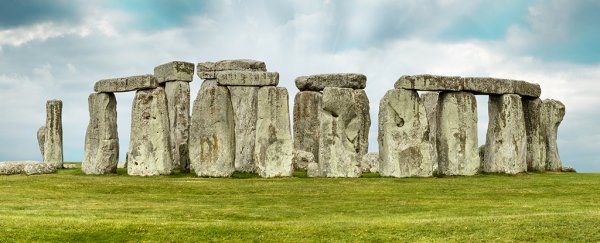Britain was something of a late bloomer as far as the Neolithic Revolution goes. While Europe sweated it out growing crops and dragging stones into circles, communities over the channel were still happily foraging and hunting for food.
An analysis of ancient remains by an international team of researchers has filled in missing details on why British culture took so long to shift, suggesting European migrants had more to do with the change than previously believed.
Farming in Europe can be traced back to practices in the near east that emerged roughly 12,000 years ago, before slowly spreading throughout the region.
Some 5,000 years later it eventually reached the lands near the far western coast, where it stalled for a thousand years before jumping the channel.
This revolution eventually presented itself not only in the form of fancy new pottery and new diets, but in the design and construction of colossal building monuments such as Stonehenge.
While this latest study concerns itself specifically with the shift to farming, rather than the origins of UK's most famous monolith, the team's work could shed light on the possible ancestors of its builders.
Usually, significant cultural shifts like these occur due to one of two things – either an established people learn a new trick or two as they mix with their neighbours, or migrants take over the land and impose their way of doing things.
Where ancient Britain was concerned, there's been extensive debate on which scenario best describes the archaeological findings around the place.
"Because continental farmer populations had mixed to some extent with local hunter-gatherers as they expanded along both the Mediterranean and Rhine-Danube corridors, as well as later, we expected to see some mixing in Britain as well," says Ian Barnes, an ancient DNA expert at Britain's Natural History Museum.
British history is no stranger to the impact of migration. Rewind the clock and you'll quickly pass through waves of French and Scandinavian conquest imposing their language and introducing their strange new cuisines.
Keep going another ten millennia, and eventually you'll find the signs of occupation in the form of a group of humans who settled the region soon after the end of the last major Ice Age.
These hunter-gatherer communities are represented by a set of 10,000 year old remains found in Cheddar Gorge more than a century ago.
'Cheddar Man', as he's called, provides us with a glimpse of what these ancient people might have been like. His dark curly hair and pale eyes are seen as rather typical of Mesolithic humans in that corner of the globe.
Work involving @nhm_london scientists has revealed the face of ‘Cheddar Man’. ‘The First Brit’ will screen on Channel 4 on Sunday 18th February. pic.twitter.com/K8p3csTwJh
— NHM Anthropology (@NHM_Anthro) February 7, 2018
While humans had already been on British soil for tens of thousands of years, Cheddar Man's family provides a convenient landmark for comparing prehistoric culture in Britain with the revolutionary shifts that set the foundations for the modern world.
Comparing his DNA with samples taken from 47 Neolithic remains dating between 6000 and 4500 years ago helped researchers determine whether the agricultural revolution was adopted by the hunter-gatherers, or if they were replaced by farmers.
"It looks like the development of farming and these Neolithic cultures was mainly driven by the migration of people from mainland Europe," says Natural History Museum anthropologist Tom Booth.
Those people from mainland Europe have their roots in a population that made their way from the Aegean, meaning the first farmers in Britain could trace their ancestry back to communities who once lived in what is today Greece and Turkey.
Strangely, they didn't seem to make their way into Britain directly across the channel as might be assumed, but more than likely through a more circuitous route through the Atlantic, settling down on Britain's western shores.
Where there are usually signs of a generous mixing of genes – and culture – between established populations and migrants, there's little sign of this melding of blood lines in this case.
Any genes introduced by Cheddar Man's kindred were swamped by the DNA of incoming populations, who the researchers believe had slightly lighter skin and darker eyes.
"It is difficult to say why this is, but it may be that those last British hunter-gatherers were relatively few in number," says evolutionary geneticist Mark G. Thomas from University College London.
Even if integration was mostly peaceful, groups of Neolithic newcomers would have had a significant advantage over holdouts of hunter gatherers. There were simply more of them than there were hunter-gatherers in the end.
It wouldn't have taken long for Cheddar Man's people to have faded from history as European farmers spread throughout their new home.
Exactly when they learned to chisel out giant rocks and turn them into massive graveyard calendars is another mystery to be solved.
Some researchers argue all of Europe's megaliths can be traced at least back to cultures that developed in northwestern France just prior to Britain's jump into the farming craze.
Whatever happened, we can be fairly confident Cheddar Man's descendants would have been less than impressed at the slow 'Brentry' of European farmers.
This research was published in Nature Ecology & Evolution.
